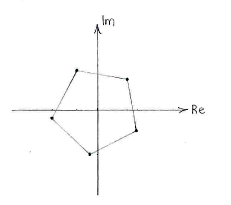Lösung 3.3:2c
Aus Online Mathematik Brückenkurs 2
K (Solution 3.3:2c moved to Lösung 3.3:2c: Robot: moved page) |
|||
| Zeile 1: | Zeile 1: | ||
| - | + | Wir bringen <math>z</math> und <math>-1-i</math> auf Polarform | |
{{Abgesetzte Formel||<math>\begin{align} | {{Abgesetzte Formel||<math>\begin{align} | ||
| Zeile 6: | Zeile 6: | ||
\end{align}</math>}} | \end{align}</math>}} | ||
| - | + | Mit den Moivreschen Gesetz erhalten wir die Gleichung | |
{{Abgesetzte Formel||<math>r^5(\cos 5\alpha + i\sin 5\alpha) = \sqrt{2}\Bigl(\cos \frac{5\pi}{4} + i\sin\frac{5\pi}{4}\Bigr)\,\textrm{.}</math>}} | {{Abgesetzte Formel||<math>r^5(\cos 5\alpha + i\sin 5\alpha) = \sqrt{2}\Bigl(\cos \frac{5\pi}{4} + i\sin\frac{5\pi}{4}\Bigr)\,\textrm{.}</math>}} | ||
| - | + | Wir vergleichen den Betrag und das Argument der beiden Seiten, und erhalten | |
{{Abgesetzte Formel||<math>\left\{\begin{align} | {{Abgesetzte Formel||<math>\left\{\begin{align} | ||
| Zeile 17: | Zeile 17: | ||
\end{align}\right.</math>}} | \end{align}\right.</math>}} | ||
| - | (The arguments <math>5\alpha</math> and <math>5\pi/4</math> can differ by a multiple of <math>2\pi</math> and still correspond to the same complex number.) | ||
| - | + | (Die Argumente <math>5\alpha</math> und <math>5\pi/4</math> können sich mit einen Multipel von <math>2\pi</math> unterscheiden, und trotzdem dieselbe komplexe Zahl entsprechen.) | |
| + | |||
| + | Wir erhalten also | ||
{{Abgesetzte Formel||<math>\left\{\begin{align} | {{Abgesetzte Formel||<math>\left\{\begin{align} | ||
| Zeile 26: | Zeile 27: | ||
\end{align}\right.</math>}} | \end{align}\right.</math>}} | ||
| - | + | Wir sehen dass das Argument <math>\alpha</math>nur 5 verschiedene Werte annimmt | |
{{Abgesetzte Formel||<math>\frac{\pi}{4}</math>, <math>\quad\frac{\pi}{4}+\frac{2\pi}{5}</math>, <math>\quad\frac{\pi}{4}+\frac{4\pi}{5}</math>, <math>\quad\frac{\pi}{4}+\frac{6\pi}{5}\quad</math> and <math>\quad\frac{\pi}{4}+\frac{8\pi}{5}</math>}} | {{Abgesetzte Formel||<math>\frac{\pi}{4}</math>, <math>\quad\frac{\pi}{4}+\frac{2\pi}{5}</math>, <math>\quad\frac{\pi}{4}+\frac{4\pi}{5}</math>, <math>\quad\frac{\pi}{4}+\frac{6\pi}{5}\quad</math> and <math>\quad\frac{\pi}{4}+\frac{8\pi}{5}</math>}} | ||
| - | + | Nachdem sich die Winkeln dann wiederholen. | |
| - | + | Die Wurzeln sind also | |
{{Abgesetzte Formel||<math>z = 2^{1/10}\,\Bigl(\cos\Bigl(\frac{\pi}{4}+\frac{2n\pi}{5}\Bigr) + i\sin\Bigl(\frac{\pi}{4}+\frac{2n\pi}{5}\Bigr)\Bigr)\,,</math>}} | {{Abgesetzte Formel||<math>z = 2^{1/10}\,\Bigl(\cos\Bigl(\frac{\pi}{4}+\frac{2n\pi}{5}\Bigr) + i\sin\Bigl(\frac{\pi}{4}+\frac{2n\pi}{5}\Bigr)\Bigr)\,,</math>}} | ||
| - | + | für <math>n=0</math>, <math>1</math>, <math>2</math>, <math>3</math> und | |
<math>4</math>. | <math>4</math>. | ||
[[Image:3_3_2_c.gif|center]] | [[Image:3_3_2_c.gif|center]] | ||
Version vom 15:26, 18. Mai 2009
Wir bringen \displaystyle z und \displaystyle -1-i auf Polarform
| \displaystyle \begin{align}
z &= r(\cos\alpha + i\sin\alpha)\,,\\[5pt] -1-i &= \sqrt{2}\Bigl(\cos\frac{5\pi}{4} + i\sin\frac{5\pi}{4}\Bigr)\,\textrm{.} \end{align} |
Mit den Moivreschen Gesetz erhalten wir die Gleichung
| \displaystyle r^5(\cos 5\alpha + i\sin 5\alpha) = \sqrt{2}\Bigl(\cos \frac{5\pi}{4} + i\sin\frac{5\pi}{4}\Bigr)\,\textrm{.} |
Wir vergleichen den Betrag und das Argument der beiden Seiten, und erhalten
| \displaystyle \left\{\begin{align}
r^5 &= \sqrt{2}\,,\\[5pt] 5\alpha &= \frac{5\pi}{4} + 2n\pi\,,\quad\text{(n is an arbitrary integer).} \end{align}\right. |
(Die Argumente \displaystyle 5\alpha und \displaystyle 5\pi/4 können sich mit einen Multipel von \displaystyle 2\pi unterscheiden, und trotzdem dieselbe komplexe Zahl entsprechen.)
Wir erhalten also
| \displaystyle \left\{\begin{align}
r &= \sqrt[5]{2} = \bigl(2^{1/2}\bigr)^{1/5} = 2^{1/10}\,,\\[5pt] \alpha &= \frac{1}{5}\Bigl(\frac{5\pi}{4}+2n\pi\Bigr) = \frac{\pi}{4} + \frac{2n\pi}{5}\,,\quad\text{(n is an arbitrary integer).} \end{align}\right. |
Wir sehen dass das Argument \displaystyle \alphanur 5 verschiedene Werte annimmt
| \displaystyle \frac{\pi}{4}, \displaystyle \quad\frac{\pi}{4}+\frac{2\pi}{5}, \displaystyle \quad\frac{\pi}{4}+\frac{4\pi}{5}, \displaystyle \quad\frac{\pi}{4}+\frac{6\pi}{5}\quad and \displaystyle \quad\frac{\pi}{4}+\frac{8\pi}{5} |
Nachdem sich die Winkeln dann wiederholen.
Die Wurzeln sind also
| \displaystyle z = 2^{1/10}\,\Bigl(\cos\Bigl(\frac{\pi}{4}+\frac{2n\pi}{5}\Bigr) + i\sin\Bigl(\frac{\pi}{4}+\frac{2n\pi}{5}\Bigr)\Bigr)\,, |
für \displaystyle n=0, \displaystyle 1, \displaystyle 2, \displaystyle 3 und \displaystyle 4.

